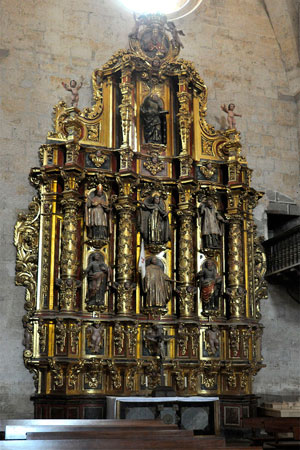Monastery of Santa María la Real de Fitero
Niencebas / Castellón / Yerga / Castelione / Fiterium
(Fitero, Navarre)
Around 1119, Alfonso I the Battler conquered from the Muslims the lands where Fitero is now located. At the end of 1140, Alfonso VII of León and Castile donated a piece of land to build a monastery in Niencebas. At that time the territory was within the dominions of the kingdom of Castile, which oversaw its colonisation, marked by an important border character. Shortly afterwards, in 1141, there is already evidence of the existence of a community there, under the rule of Abbot Raymond of Fitero.
At an unspecified date, in the middle of the 12th century, this same abbot moved the monastery from the site of the original settlement to the definitive site of Fitero, also known as Castellón. It is believed that the first monastery was Benedictine and that it was later linked to the Cistercian Order. Despite the different opinions, the fact is that it is not until 1147 (perhaps as early as 1145) that this house is unmistakably referred to as Cistercian, dependent on Escaladieu Abbey (Hautes-Pyrénées, France). That abbot Raymond organised an important militia at the request of Sancho III of Castile in order to defend the place of Calatrava (Ciudad Real). In 1158, once this objective had been achieved, the king gave it to Fitero, where the military order of Calatrava would later develop.
Thanks to its border location, the monastery of Fitero was the beneficiary of important donations from Castilian and Navarrese monarchs, which, on the other hand, was also negatively affected by the disputes between the two kingdoms over the monastery and, above all, its riches. After the death of the first abbot (Raymond, venerated as a saint) the place was stormed by the forces of the bishop of Tarazona, who incorporated it into his diocese, with the new abbot: Guillermo. It quickly became an important Cistercian centre in the Navarre area: La Oliva and also Veruela (Zaragoza), founded on land belonging to Fitero and, like the latter, also linked to Escaladieu, depended on it. Construction of the monastery began at the end of the 12th century (1181?) and continued for a long time, well into the 13th century. The church was consecrated in 1247.
Until 1373 Fitero was part of the kingdom of Castile, but at that time it was incorporated into the kingdom of Navarre. During the first half of the 16th century, the population of Fitero grew up in the shadow of the monastery, at a time when the house was going through a period of decadence. Later, the community was reformed and joined the congregation of Aragon, despite the pretensions of the congregation of Castile. The monastery maintained its activity, with greater or lesser vitality until 1835, when the monks abandoned it due to the disentailment. Before that, they had suffered the temporary exclaustrations of the Peninsular War and the Liberal Triennium. From then on, the church became a parish church and thanks to this it has been preserved, as well as the cloister and the chapterhouse, in addition to the convent buildings that were erected in modern times.
Affiliation of Fitero
According to Originum Cisterciensium (L. Janauschek, 1877)- ARIGITA Y LASA, Mariano (1900). Cartulario de Santa María la Real de Fitero. Colección de documentos inéditos para la Historia de Navarra. Vol. 1. Pamplona: Imp. Provincial
- FERNÁNDEZ GRACIA, Ricardo (1993). Iconografía de San Raimundo de Fitero. Príncipe de Viana, núm. 54
- FERNÁNDEZ, Ricardo (1997). El monasterio de Fitero. Arte y arquitectura. Pamplona: Gobierno de Navarra
- GOÑI GAZTAMBIDE, José (1965). Historia del monasterio cisterciense de Fitero. Príncipe de Viana. Núm. 100-101
- JANAUSCHEK, Leopoldus (1877). Originum Cisterciensium. Vol. 1. Viena
- LAMPÉREZ, Vicente (1905). El Real Monasterio de Fitero, en Navarra. (Apuntes para una monografía). Boletín de la Real Academia de la Historia, vol. 46
- MARTÍNEZ, Carlos J. (2017). Del románico al gótico en la arquitectura de Navarra: Monasterios, iglesias y palacios. Gobierno de Navarra
- MELERO MONEO, Marisa (2004). Reflexiones sobre el Monasterio cisterciense de Santa María de Fitero. De Arte, núm. 3
- MELERO MONEO, Marisa; i altres (2007). Fitero: el legado de un monasterio. Fundación para la Concervación del Patrimonio Histórico de Navarra
- OLCOZ YANGUAS, Serafín (2007). El tesoro del patrimonio histórico de Fitero. Fitero: Ayuntamiento de Fitero
- OLCOZ YANGUAS, Serafín (2008). Fitero Cisterciense, del Monasterio a la Villa (Siglos XII-XV). Tracasa. Ayuntamiento de Fitero
- OLCOZ YANGUAS, Serafín (2011). El monasterio cisterciense de Fitero, diócesis de Calahorra. Kalakorikos, núm. 16
- OLCOZ YANGUAS, Serafín (2019). El inexistente monasterio de Yerga y el origen del monasterio de Fitero. Príncipe de Viana, núm. 274























